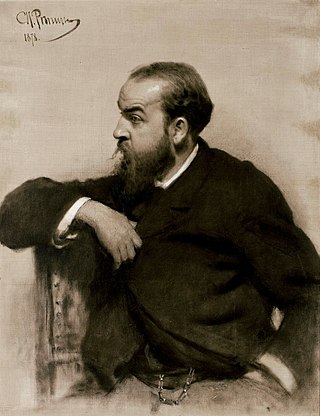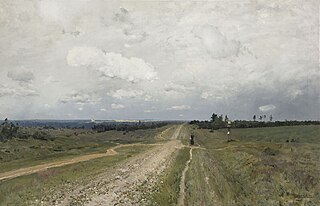
Ilya Yefimovich Repin was a Ukrainian-born Russian painter. He became one of the most renowned artists in Russia in the 19th century. His major works include Barge Haulers on the Volga (1873), Religious Procession in Kursk Province (1880–1883), Ivan the Terrible and His Son Ivan (1885); and Reply of the Zaporozhian Cossacks (1880–1891). He is also known for the revealing portraits he made of the leading literary and artistic figures of his time, including Mikhail Glinka, Modest Mussorgsky, Pavel Tretyakov, Pantaleon Szyndler, and especially Leo Tolstoy, with whom he had a long friendship.

Ivan Konstantinovich Aivazovsky was a Russian-Armenian Romantic painter who is considered one of the greatest masters of marine art. Baptized as Hovhannes Aivazian, he was born into an Armenian family in the Black Sea port of Feodosia in Crimea and was mostly based there.

Pavel Mikhaylovich Tretyakov was a Russian businessman, patron of art, collector, and philanthropist who gave his name to the Tretyakov Gallery and Tretyakov Drive in Moscow. His brother Sergei Tretyakov was also a famous patron of art and a philanthropist.

Valentin Alexandrovich Serov was a painter and one of the premier portrait artists of his era. He was from the Russian Empire.

The State Tretyakov Gallery is an art gallery in Moscow, Russia, which is considered the foremost depository of Russian fine art in the world.

Mikhail Vasilyevich Nesterov was a Russian and Soviet painter; associated with the Peredvizhniki and Mir Iskusstva. He was one of the first exponents of Symbolist art in Russia.

The Rumyantsev Museum evolved from the personal library and historical collection of Count Nikolay Rumyantsev (1754–1826). Its origin was in St. Petersburg in the Rumyantsev house or mansion, building number 44 on the English Embankment overlooking river Neva. After Nikolay died in 1826, his brother Sergei converted the house into a museum. It was opened to the general public in 1831, initially for one day a week, and the remaining days were for study.

Emily Shanks, also known as Emiliya Yakovlevna Shanks, was a British painter living in Moscow. She was the first woman to be elected to the Russian Society for Travelling Art Exhibitions or Peredvizhniki.

Ilya Semyonovich Ostroukhov was a Russian landscape painter and art collector, associated with the Peredvizhniki.

Rafail Sergeevich Levitsky was a Russian and Soviet genre, romantic, and impressionist artist who was an active participant in the Peredvizhniki (Itinerant) Movement.

The Kolodzei Art Foundation, Inc. promotes the contemporary art of Russia and Eastern Europe. The Kolodzei Art Foundation often utilizes the artistic resources of the Kolodzei Collection of Russian and Eastern European Art, one of the world's largest private collections, with over 7,000 artworks by over 300 artists from Russia, Eastern Europe and the former Soviet Union.

Oleg Sergeyevich Prokofiev was an artist, sculptor and poet, and the son of composer Sergei Prokofiev.

Yuri Nilovich Tulin was a Soviet Russian painter and Honored Artist of the Russian Federation. He lived and worked in Leningrad and is regarded as one of the brightest representatives of the Leningrad school of painting, most famous for his portraits and historical paintings.

Alexander Mikhailovich Lyubimov was a Russian Empire and later Soviet realist painter, graphic artist, illustrator, and art teacher, professor of Repin Institute of Arts and Vera Mukhina Higher School of Art and Industry, who lived and worked in Leningrad. He was a member of the Leningrad Union of Artists and regarded as one of founder and the brightest representatives of the Leningrad school of painting, most famous for his portrait paintings and satirical drawings.

Piotr Petrovich Belousov was a Ukrainian and Russian graphic artist, painter, art teacher, professor of the Ilya Repin Leningrad Institute of Painting, Sculpture and Architecture, People's Artist of the USSR, corresponding member of the Academy of Arts of the USSR, who lived and worked in Leningrad. He was regarded as one of the brightest representatives of the Leningrad school of painting, being most famous for his portraits and historical paintings.
Pavel Pepperstein is a Russian artist and writer.
Vereshchagin's Turkestan Series is a collection of 13 paintings produced by Russian artist Vasily Vereshchagin in the 19th-century. While initially purchased en masse by a Russian collector, the works have since been added to the collections of the Tretyakov Gallery in Moscow and the Russian Museum in Saint Petersburg.
Valery Alexandrovich Volkov was a Soviet-Russian painter and art historian who lived and worked in Central Asia and in Russia. Intercultural experiences and knowledge gleaned from the art history of two different cultures was reflected in a distinctive fusion of influences in his paintings. His painting style is associated with abstract expressionism and merges a sensual world of colour of the Orient and the gestural brush technique of European modernism.

They Did Not Expect Him is a painting by realist artist Ilya Repin made between 1884 and 1888. It depicts the return of a narodnik from exile and his family's reaction. The painting is part of Repin's "Narodniki" series, which includes four other artworks.

Vladimirka is an 1892 oil painting by the Russian artist Isaac Levitan. The painting depicts the Vladimir Highway, a dirt road leading east from Moscow to Vladimir. Vladimirka is one of three large paintings by Levitan completed in the first half of the 1890s. Together with By the Pool (1892) and Over Eternal Peace (1894), they are sometimes referred to as Levitan's "gloomy trilogy".

















